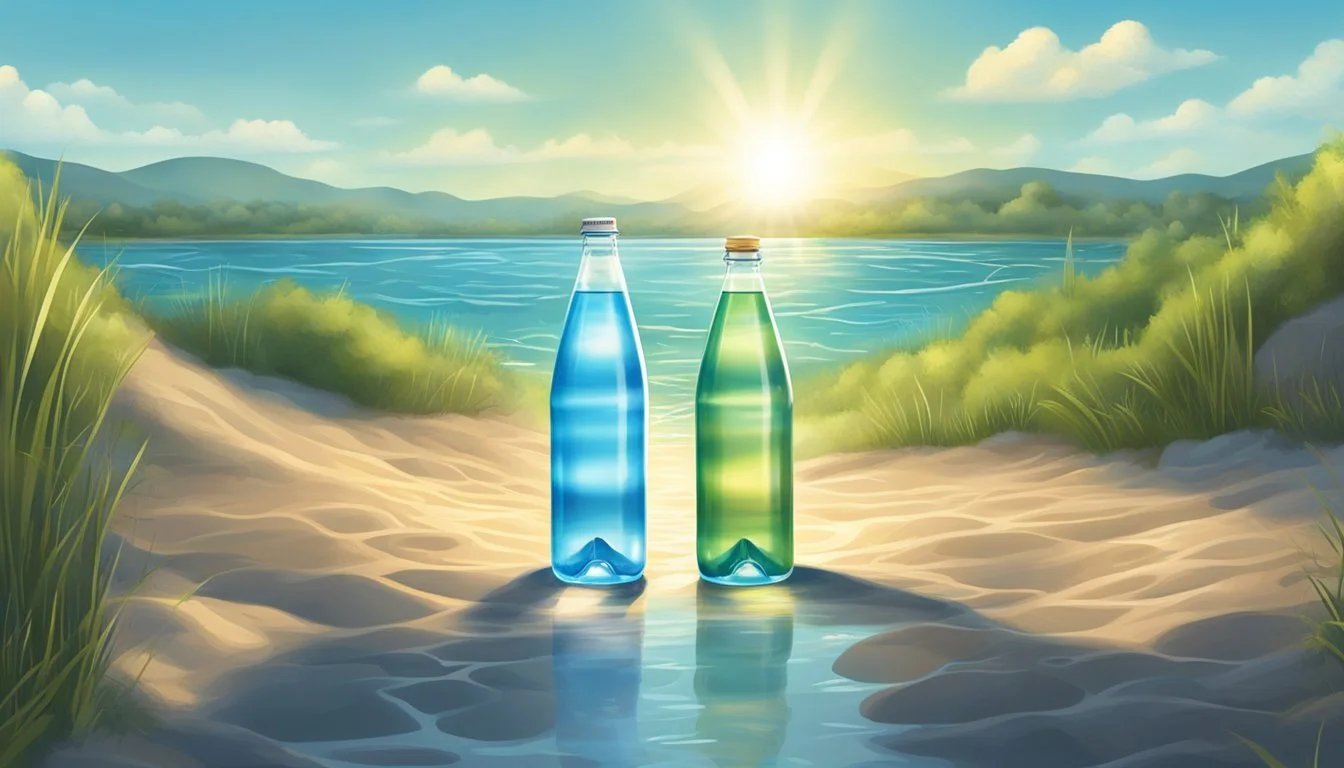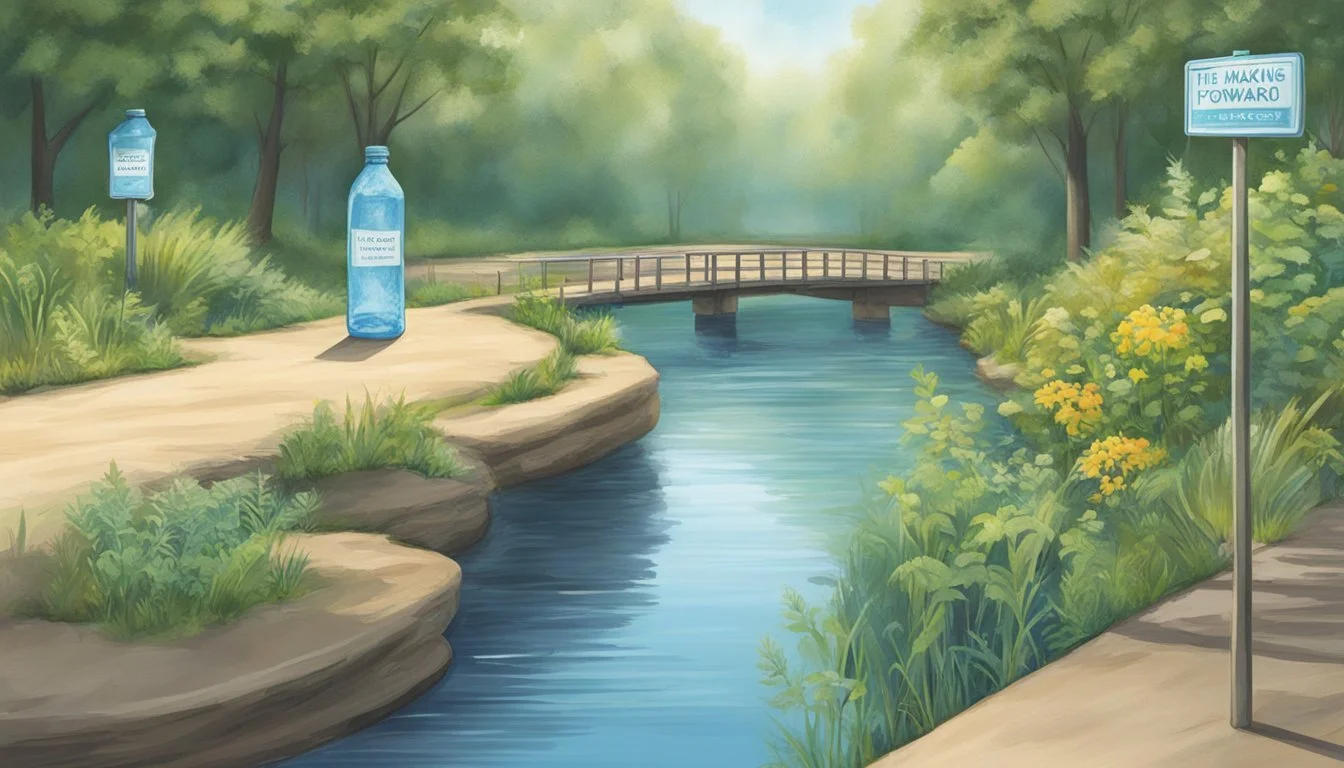Path vs. Open Water
Which Bottled Water is Better? Comprehensive Comparison and Insights
When it comes to choosing the best bottled water, comparing Path and Open Water offers some insightful revelations. Path sets itself apart with its environmentally conscious approach, offering purified water in refillable aluminum bottles. This not only reduces single-use plastic waste but also maintains the water at a cooler temperature for longer durations. Path's commitment to sustainability and its innovative packaging solution make it a strong contender in the market.
On the other hand, Open Water also prioritizes sustainability by packaging its water in 100% recyclable aluminum bottles. Both Path and Open Water aim to protect the environment while providing high-quality hydration. However, Open Water's unique selling point is its carbon-neutral certification, positioning it as a truly eco-friendly choice. This emphasis on carbon neutrality ensures that their environmental impact is kept to a minimum.
Ultimately, both brands demonstrate strong dedication to sustainability and quality. For environmentally conscious consumers, the choice might hinge on personal preferences for packaging and brand ethos. Whether opting for Path's refillable versatility or Open Water's carbon-neutral mission, both brands offer excellent alternatives to traditional plastic bottled water.
Understanding Types of Drinking Water
There are various types of drinking water available, each with unique characteristics and sources. It is essential to understand these differences to make an informed choice about the water you consume.
Bottled Water Varieties
Bottled water comes in several forms, including mineral water, spring water, and artesian well water. Mineral water contains naturally occurring minerals and is sourced from mineral springs. It is often prized for its taste and health benefits. Spring water is collected directly from a natural spring and must be bottled at the source. It retains its natural composition and is often marketed as pure and refreshing.
Artesian well water is drawn from a well that taps a confined aquifer. This type of water is under natural pressure, allowing it to flow naturally to the surface. Bottled water is subject to regulations that ensure its safety, but it can vary in mineral content and taste depending on the source. It is important to check the label for specific details about the water's origin and composition.
Tap Water and Its Sources
Tap water primarily originates from municipal sources and is treated to meet safety standards set by government agencies. It is usually sourced from rivers, lakes, or underground aquifers. Treatment processes may include filtration, disinfection, and the addition of chemicals like fluoride for dental health benefits.
In rural areas, well water is another type of tap water, drawn directly from the ground without extensive municipal treatment. While typically safe, well water may require regular testing to ensure it is free of contaminants. Municipal water systems are generally reliable and convenient, offering an economical and environmentally-friendly option compared to bottled water.
Tap water is typically inexpensive and highly regulated, making it a practical choice for everyday use.
Comparing Water Quality and Safety
Bottled water and tap water both undergo regulation to ensure safety and quality. Understanding the distinct roles of the EPA and FDA, as well as the processes used to treat water and eliminate contaminants, is critical.
EPA and FDA Regulations
The Environmental Protection Agency (EPA) regulates tap water under the Safe Drinking Water Act. This act ensures that public water systems comply with health standards addressing contaminants like lead, chlorine, and fluoride.
The Food and Drug Administration (FDA) oversees bottled water. It enforces standards for contaminants such as bacteria, chemicals, and microplastics. The FDA’s regulations are modeled after the EPA’s but can differ in enforcement and scope.
Water Treatment and Contaminants
Tap water treatment often involves processes like reverse osmosis, carbon filtration, and chlorination to remove bacteria and chemicals. Fluoride is frequently added for dental health benefits.
Bottled water companies might use different purification methods depending on the source. Common techniques include carbon filtering and UV treatment to ensure safety. Although some bottled water brands claim higher purity, it's crucial to check the label for specifics.
While both sources meet safety standards, individuals with specific health needs or preferences might choose one over the other based on treatment methods and potential contaminants.
Health Implications of Water Choices
Choosing between bottled water and tap water can have various health implications, ranging from hydration benefits to risks from potential contaminants. Understanding these can help consumers make informed decisions.
Hydration and Human Health
Staying hydrated is crucial for maintaining optimal health. Adequate water intake supports bodily functions such as digestion, temperature regulation, and nutrient transport. Both bottled water and tap water generally meet hydration needs effectively.
Bottled water often comes in convenient packaging, making it easier to carry and consume on the go. This convenience might encourage people to drink more water throughout the day.
Tap water, widely available at home and in public places, also provides an excellent source of hydration. It's usually free or very low-cost, making it accessible to a broader population. Most municipal tap water undergoes treatment to ensure safety and quality, maintaining hydration benefits without significant expense.
Risks Associated with Contaminated Water
Water contamination poses a significant health risk regardless of its source. Bottled water can sometimes be less regulated than tap water, potentially leading to quality issues. Contamination could occur during bottling or from the plastic bottles themselves, particularly if they are left in hot environments.
Tap water, while generally safe in many regions, can still be at risk for contamination from old pipes or local environmental factors. Lead, bacteria, and chemical run-off are potential hazards that can compromise water quality. Regular testing and maintenance of municipal water systems are essential to minimize these risks, but consumers should stay informed about their local water quality reports.
In both cases, proper storage and handling of water, whether bottled or from the tap, are critical to prevent contamination and ensure safety for consumption.
Environmental Impact of Water Consumption
Bottled water consumption presents a significant environmental challenge. The choice between single-use and reusable bottles can greatly affect plastic pollution and sustainability efforts.
Single-Use vs. Reusable Bottles
Using single-use plastic bottles contributes dramatically to plastic waste. Single-use plastics are rarely recycled, leading to large quantities of plastic pollution.
Reusing bottles, especially those made from environmentally friendly materials like aluminum or glass, greatly reduces environmental impact. Aluminum bottles are sustainable and can be part of a circular economy, repeatedly recycled without loss of quality.
Reusable bottles help in minimizing plastic waste and promoting sustainable consumption.
The Plastic Crisis and Recycling
The rise in bottled water consumption exacerbates the plastic crisis. Producing plastic bottles requires significant resources, including water, exacerbating environmental strain.
Recycling is not sufficient to address the problem, as most plastic bottles do not get recycled. Improving recycling rates and adopting a circular economy approach can mitigate some impact.
Environmentally friendly alternatives, such as bottles made from recycled materials, are crucial in reducing overall plastic pollution.
Practical Considerations of Water Selection
When choosing between tap and bottled water, several practical factors such as taste, convenience, and emergency availability play crucial roles. Each option offers unique benefits and drawbacks that can influence your decision.
Taste and Smell Experiences
Taste and smell are critical factors for many people when selecting water. Tap water often varies in taste depending on the source and local treatment processes, sometimes carrying a slight chlorine scent. In contrast, bottled water brands frequently advertise a crisp, clean taste with no noticeable odors, making it an attractive option for those sensitive to these factors. Some bottled waters are infused with minerals to enhance flavor, which can be appealing for some consumers.
Convenience and Accessibility
Convenience is another significant consideration. Tap water is readily available at home, making it an extremely accessible and inexpensive option. You can find bottled water at grocery stores, vending machines, and convenience stores, providing an easy solution when you are on the go. Bottled water comes in various packaging sizes, offering portability and ease of use, though at a higher price compared to tap water.
Water Accessibility in Emergencies
In emergency situations, access to clean water is paramount. Tap water systems may be compromised during natural disasters or infrastructure failures, leading to boil water advisories. Bottled water serves as a reliable alternative during such emergencies, given its long shelf life and ease of storage. It is advisable to keep a supply of bottled water for situations where tap water might not be safe or available.
Being mindful of these practical aspects aids in making an informed choice suitable for your personal needs and circumstances.
Economic Aspects of Water Choices
When evaluating the economic aspects of bottled water, the cost comparison with tap water is critical. Price variances, the impact on household budgets, and the broader economic implications should all be considered.
Cost Comparison of Bottled vs. Tap Water
Bottled water is generally significantly more expensive than tap water. On average, a gallon of bottled water can cost around $1.22, whereas tap water is often only a fraction of a cent per gallon. For households relying on bottled water, these expenses can accumulate quickly.
Moreover, bottled water comes in various price ranges depending on the brand and type, from basic options to high-end products. This variety enables consumers to choose based on their budget, but consistently purchasing even the less expensive brands is still costlier than using tap water.
The economic viability of tap water is clear, especially when considering environmental costs. Bottled water often involves additional expenses such as packaging, transportation, and retail mark-ups. These factors contribute to the higher price, making it less economical for daily use.
Economic impacts also stretch beyond individual costs. The bottled water industry supports numerous jobs and generates significant revenue, contributing to the economy. However, the long-term economic sustainability of high bottled water consumption is debatable due to environmental costs.
Innovations in Water Consumption
Significant innovations in water consumption focus on improving health, sustainability, and convenience. These advancements range from enhanced bottling and filtration technologies to the integration of smart features in reusable water bottles.
Advancements in Water Bottling and Filtration
Modern bottled water brands like Mitte emphasize advanced filtration techniques to deliver purified water. They use sophisticated water filters to remove contaminants while retaining beneficial minerals.
Filtered tap water remains an economical choice, reducing environmental impact compared to single-use plastic bottles. The prevalence of reusable bottled water options highlights the shift towards sustainability. These bottles often incorporate smart technology to encourage better hydration habits through goals, reminders, and tracking features.
While traditional bottled water still leads in market popularity, innovations push the boundaries toward cleanliness and environmental responsibility. Sustainable bottled water solutions aim to balance convenience with eco-conscious practices.
Bottled Water Brands and Their Approaches
Premium water brands offer unique attributes such as advanced filtration methods and enhanced mineral content. Some focus on purity and taste, while others emphasize environmental sustainability or added health benefits.
Premium Water Brands Overview
Many premium brands position themselves at the top of the market by leveraging the purity, source, and taste of their water.
Evian and Fiji are known for their clean taste and natural mountain or volcanic sources. Evian comes from the French Alps, boasting natural spring water rich in minerals. Fiji markets its water from an artesian aquifer in Fiji, credited for its soft and smooth taste.
Voss, originating from Norway, highlights its artesian source and minimalist design. Essentia offers ionized alkaline water with a pH of 9.5, targeting consumers looking for hydration with an extra kick of electrolytes. Smartwater, part of the Coca-Cola family, focuses on vapor-distilled water with added electrolytes for a crisp taste.
Core Hydration is designed to work with the body's natural pH balance, usually around 7.4, emphasizing hydration and balanced minerals. Meanwhile, Pathwater focuses on sustainability, featuring reusable aluminum bottles filled with purified water.
Assessing Claims of Enhanced Waters
Bottled water brands often market themselves based on enhanced features such as added electrolytes, pH levels, or ethical sourcing practices.
Smartwater and Core Hydration promote their advanced purification and added electrolytes, asserting these enhance taste and hydration efficiency. Essentia claims its ionized alkaline water aids in better hydration, though health benefits over regular purified water remain debated.
LifeWtr, a premium offering from PepsiCo, emphasizes electrolyte addition for taste and pH balance, besides featuring artwork on its packaging.
Claims about pH levels and structure improvements like Alkaline Water with higher pH claim health benefits, which lack substantial scientific support. Public opinions vary on the true value brought by these enhancements compared to standard purified options like Aquafina and Dasani, both well-known yet straightforward choices processed through standard filtration methods.
Focus on transparent sources and chemical-free processes is common for brands like Pathwater and Nestle Pure Life, resonating with environmentally-conscious consumers. Effective marketing and specific feature focus help these premium brands stand out in a crowded market.
The Way Forward: Making Informed Choices
Consumers have more options than ever when it comes to choosing how to hydrate. With the rise of awareness about sustainability and quality, understanding the benefits of different choices is critical.
Choosing filtered water over bottled water can be more economical in the long run. Although a home filtration system has an initial cost, the price per liter of filtered water becomes lower than continuously buying bottled water.
Concerns about the source and quality of bottled water emphasize the importance of transparency. Check if the brand provides water quality reports, lists treatment methods, and specifies the water source. This information helps assure the safety and quality of the bottled water.
Reusable water bottles offer a sustainable choice. They help reduce plastic waste and are cost-effective since filtered tap water or any safe water source can be used. Reusable bottles are also convenient for travel and daily use.
When choosing bottled water, consider brands that prioritize environmental responsibility. Some companies are now using recycled plastics or alternative materials, reducing the footprint of single-use bottles.
Here's a comparison for reference:
Option Pros Cons Filtered Water Economical, environmentally friendly Initial setup cost Bottled Water Convenient, often deemed safer Expensive, potential for plastic waste Reusable Water Bottle Reduces waste, cost-effective, convenient Initial purchase cost, requires cleaning
For those looking to minimize environmental impact and save money, filtered water used in a reusable bottle can be an excellent choice. Knowledgeable decisions about hydration sources not only impact health but also contribute to sustainability efforts.
More About Path
Mountain Valley Spring Water vs Path: Which Bottled Water is Better?
Path vs Whole Foods Italian Still Mineral water: Which Bottled Water is Better?
More About Open Water
Aqua Carpatica vs Open Water: Which Bottled Water is Better?
Cascade Mountain vs Open Water: Which Bottled Water is Better?
Core Hydration vs Open Water: Which Bottled Water is Better?
Crystal Geyser vs Open Water: Which Bottled Water is Better?
Hawaii Volcanic vs Open Water: Which Bottled Water is Better?
Hawaiian Springs vs Open Water: Which Bottled Water is Better?
Icelandic Glacial vs Open Water: Which Bottled Water is Better?
Mountain Valley Spring Water vs Open Water: Which Bottled Water is Better?
Nestle Pure Life vs Open Water: Which Bottled Water is Better?
Open Water vs Kirkland Signature: Which Bottled Water is Better?
Open Water vs Whole Foods 365: Which Bottled Water is Better?
Richard's Rainwater vs Open Water: Which Bottled Water is Better?
San Pellegrino vs Open Water: Which Bottled Water is Better?
Solan de Cabras vs Open Water: Which Bottled Water is Better?
Talking Rain AQA vs Open Water: Which Bottled Water is Better?
Whole Foods Italian Still Mineral water vs Open Water: Which Bottled Water is Better?








